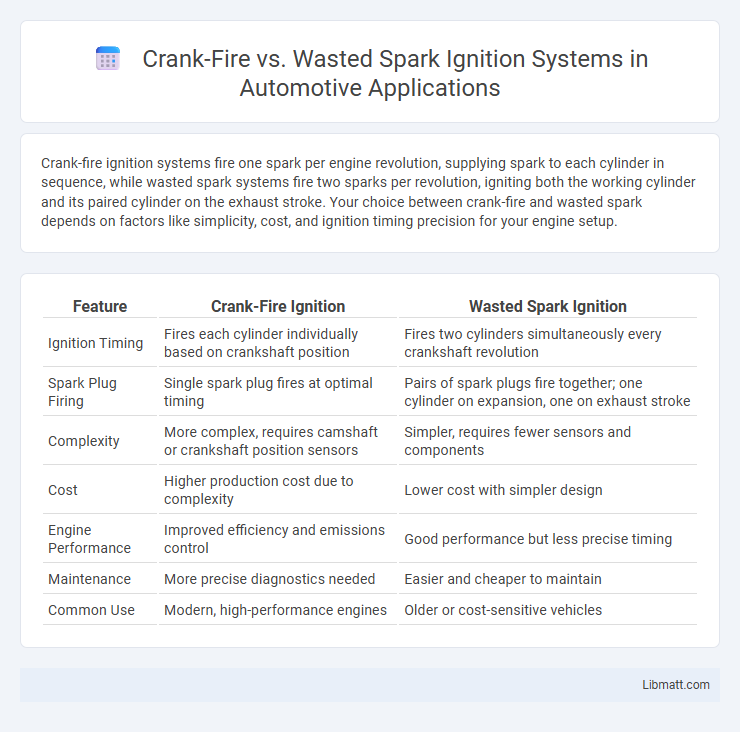Crank-fire ignition systems fire one spark per engine revolution, supplying spark to each cylinder in sequence, while wasted spark systems fire two sparks per revolution, igniting both the working cylinder and its paired cylinder on the exhaust stroke. Your choice between crank-fire and wasted spark depends on factors like simplicity, cost, and ignition timing precision for your engine setup.
Table of Comparison
| Feature | Crank-Fire Ignition | Wasted Spark Ignition |
|---|---|---|
| Ignition Timing | Fires each cylinder individually based on crankshaft position | Fires two cylinders simultaneously every crankshaft revolution |
| Spark Plug Firing | Single spark plug fires at optimal timing | Pairs of spark plugs fire together; one cylinder on expansion, one on exhaust stroke |
| Complexity | More complex, requires camshaft or crankshaft position sensors | Simpler, requires fewer sensors and components |
| Cost | Higher production cost due to complexity | Lower cost with simpler design |
| Engine Performance | Improved efficiency and emissions control | Good performance but less precise timing |
| Maintenance | More precise diagnostics needed | Easier and cheaper to maintain |
| Common Use | Modern, high-performance engines | Older or cost-sensitive vehicles |
Introduction to Crank-Fire and Wasted Spark Systems
Crank-fire systems synchronize fuel injection and ignition with the crankshaft position sensor to optimize engine timing, improving combustion efficiency and performance. Wasted spark ignition systems fire two spark plugs simultaneously, one in the cylinder undergoing the power stroke and the other in the cylinder on its exhaust stroke, reducing ignition system complexity and cost. Your choice between these ignition types impacts engine control precision, maintenance, and overall efficiency.
How Crank-Fire Ignition Works
Crank-fire ignition synchronizes spark timing directly with the crankshaft position, firing each spark plug at precise intervals for efficient combustion. This system uses a single ignition coil per cylinder, delivering sparks exactly when the piston reaches the top dead center during its compression stroke. By monitoring crankshaft signals, crank-fire ignition enhances engine performance and fuel efficiency compared to wasted spark systems.
Wasted Spark Ignition System Explained
The wasted spark ignition system fires two spark plugs simultaneously, one on the compression stroke and one on the exhaust stroke, which simplifies ignition timing without needing a camshaft position sensor. Crank-fire ignition systems rely solely on the crankshaft position sensor to time spark events, firing one spark plug per cylinder at the correct moment. Your engine benefits from a wasted spark system through reduced complexity and improved reliability in spark plug ignition timing.
Key Differences Between Crank-Fire and Wasted Spark
Crank-fire ignition systems fire each spark plug individually in sync with the crankshaft's position, optimizing spark timing for precise combustion control. Wasted spark systems fire pairs of spark plugs simultaneously, one on the compression stroke and one on the exhaust stroke, which simplifies design but can reduce efficiency. The main differences lie in firing sequence precision, system complexity, and fuel efficiency impact.
Performance Comparison: Crank-Fire vs Wasted Spark
Crank-fire ignition systems deliver sparks precisely timed to each cylinder's individual combustion event, optimizing fuel efficiency and power output for superior engine performance. Wasted spark systems fire spark plugs in pairs, resulting in less precise timing and slightly reduced fuel efficiency, although they offer simpler design and lower cost. Your vehicle can benefit from crank-fire technology if enhanced throttle response and smoother power delivery are priorities over the economical advantages of wasted spark setups.
Installation and Maintenance Considerations
Crank-fire ignition systems require precise sensor alignment on the crankshaft for accurate timing, making installation more complex than wasted spark systems, which are simpler to set up due to firing pairs on each cylinder. Maintenance of crank-fire systems often involves sensor calibration and more frequent checks to ensure signal integrity, whereas wasted spark setups benefit from fewer sensors and more straightforward diagnostics. Understanding these differences helps optimize engine performance and reliability by selecting the appropriate ignition strategy based on serviceability and installation environment.
Cost Analysis: Crank-Fire vs Wasted Spark
Crank-fire ignition systems generally involve higher costs due to the need for a dedicated camshaft position sensor and a more complex control module, while wasted spark systems are more cost-effective by firing spark plugs in pairs without a cam sensor. Wasted spark systems reduce expenses on parts and labor, making them ideal for budget-conscious vehicle maintenance or upgrades. Your choice between crank-fire and wasted spark should consider initial investment and long-term reliability to balance performance and budget.
Reliability and Longevity of Each System
Crank-fire ignition systems offer higher reliability due to precise timing, reducing misfires and stress on engine components, which enhances overall longevity. Wasted spark systems, while simpler and cost-effective, expose ignition components to additional wear since each coil fires twice per cycle, potentially shortening lifespan. Your engine's durability benefits most from crank-fire setups, especially in performance or demanding driving conditions.
Suitability for Different Engine Types
Crank-fire ignition systems are highly suitable for engines with individual coil packs per cylinder, providing precise control and eliminating cross-spark issues, making them ideal for modern multi-cylinder engines. Wasted spark ignition systems perform well in simpler, older engine designs with fewer coils, as they fire two spark plugs simultaneously, effectively reducing complexity and cost while maintaining reliable performance. Your choice between these systems should consider engine design, operational precision requirements, and maintenance preferences to optimize performance and efficiency.
Choosing the Right Ignition System for Your Vehicle
Choosing the right ignition system for your vehicle depends on factors like engine type, performance needs, and budget. Crank-fire ignition systems are simpler and reliable for older engines but may lack efficiency and spark control. Wasted spark systems offer improved spark timing and better fuel combustion, enhancing performance and emissions; understanding these differences helps you select an ignition system that maximizes your vehicle's efficiency and reliability.
crank-fire vs wasted spark Infographic

 libmatt.com
libmatt.com